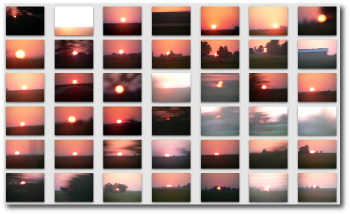
These thumbnails show 42 of 56 photos taken during the interval from 6:56:27 PM to 7:00:26 PM CDT on September 16th, 2006, at spacing of roughly 3.2 seconds per frame. We were northbound on Interstate 57, north of Tuscola, Illinois.
I’ve processed the frames into animations, which can be accessed in mov and mp4 formats: tuscola.mov (200 kB) and tuscola.mp4 (600 kB). There’s an interesting sense of high-speed motion imparted by the differential blur and the decreasing altitude of the Sun above the horizon. I used a zoom factor of 10x, and was aided by the extremely level landscape. It was very flat because we were just north of the maximum southern extent of the Wisconsinan glaciation, which retreated just 13,000 years ago.
The animation demonstrates that just south of 40 degrees north latitude, the duration of Sunset near the equinox is just under three minutes. As I watched the Sun go down, I was thinking about the fact that the Earth’s motion through its orbit is creating transits observable (in September) to observers located on planets orbiting specific stars lying in Pisces.
Here on Earth, observations of transiting extrasolar planets are mediated by a complex beat pattern between the diurnal and seasonal cycles of the Earth, and the alien periodicity of the transiting planet. Assuming clear weather, in order to catch a complete predicted transit it needs to be dark, and at least a transit duration before dawn. In addition, the target star needs to maintain a sufficient altitude above the horizon during the course of the transit.
These constraints have restricted the aggregate of known transits to objects with periods of 4 days or less. From a single location on Earth, it’s very hard to find and confirm transiting planets with longer periods. With a global network, however, the problem is more manageable, essentially because it’s always 5pm somewhere. Several years ago, we published a detailed analysis which shows quantitatively how a network of small telescopes gains in advantage over a single large telescope at a fixed location as the planetary period increases.
